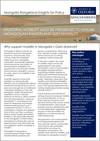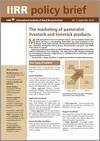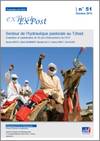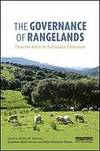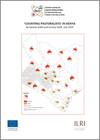Pastoral mobility must be preserved to ensure Mongolian rangeland sustainability. Pastoralism in Mongolia is currently going through major transformations (pasture user groups, cooperatives, draft Land Law, climate change, conflicting forms of land use i.e. mining, cropping, national reserves). In this new context, the value of mobility might not be fully appreciated in new policy formulations, which could weaken Mongolian pastoral systems. Supporting mobility requires an adequate institutional framework in the provision of services (e.g. water, veterinary, education and health) and institutional flexibility with stronger and reciprocal intersoum inter-aymag agreements for hosting neighboring herders during climate shocks.
Year of publication: 2014Organization: University of Oxford
Topic: Organization
Language: English
Type of document: Policies and legislation
Geographical coverage: Central Asia
This brief lists a range of policies to support pastoralists to market their products.
Year of publication: 2014Organization: International Institute of Rural Reconstruction (IIRR)
Topic: Economy
Language: English
Type of document: Technical, Policies and legislation
Geographical coverage: Eastern Africa
This evaluation has three objectives: i) evaluate the overall relevance and coherence of AFD Group interventions; ii) assess the performance of pastoral water projects; iii) propose strategies for continuing the process (with significant changes) or gradually winding it down. This exercise covered 11 projects implemented in three areas of Chad between 1993 and 2013.
Year of publication: 2014Organization: French Development Agency (AFD)
Topic: Land
Language: English, Français
Type of document: Technical
Geographical coverage: Central Africa
Pastoralism lies at the nexus of the three pillars of sustainability and provides a combination of social, environmental and economic benefits. It exploits vast areas of land that may be best suited to multi-purpose use: extensive production of high quality food products combined with delivery of high value ecosystem services. Policies, public services and investments have to be tailored to support this combination of uses and to ensure that the full range of benefits are adequately compensated and protected.
Year of publication: 2014Organization: International Union for Conservation of Nature (IUCN), United Nations Environment Programme (UNEP)
Topic: Economy, Environmental services
Language: العربية, 漢語, English, Français, Русский, Español
Type of document: Technical
Geographical coverage: Global
This field manual supports planning and management in rangelands including in village land use planning.
Year of publication: 2014Organization: International Land Coalition (ILC)
Topic: Land
Language: English
Type of document: Technical
Geographical coverage: Eastern Africa
Rangelands are large natural landscapes that can include grasslands, shrublands, savannahs and woodlands. They are greatly influenced by, and often dependent on, the action of herbivores. In the majority of rangelands the dominant herbivores are found in domestic herds that are managed by mobile pastoralists. Most pastoralists manage their rangelands communally, benefitting from the greater flexibility and seasonal resource access that common property regimes can offer. As this book shows, this creates a major challenge for governance and institutions.
Year of publication: 2014Organization: International Union for Conservation of Nature (IUCN)
Topic: Land, Organization
Language: English
Type of document: Technical
Geographical coverage: Global
The Post-2015 Agenda provides an opportunity to work globally towards making livestock production systems more sustainable while finding solutions for the conservation and sustainable use of ecosystems such as rangelands. This fact sheet presents overlooked facts, myths and emerging issues regarding pastoralism and gives recommendations on how to work towards sustainable pastoralism.
Year of publication: 2014Organization: International Union for Conservation of Nature (IUCN), United Nations Environment Programme (UNEP)
Topic: Economy, Environmental services, Participation
Language: English
Type of document: Technical
Geographical coverage: Global
What is the magnitude of pastoralism? The issue of the social and economic importance of pastoral systems is closely related with policies of land use. Overestimating the importance of pastoral systems, or downplaying it, can slow down development and lead to undesirable consequences. This study looks at the demand, the supply, and the future concerning data on the magnitude of pastoral systems in Kenya.
Year of publication: 2014Organization: Drylands Learning and Capacity Building Initiative for Improved Policy and Practice in the Horn of Africa (DLCI), Individual authors
Topic: Economy
Language: English
Type of document: Scientific
Geographical coverage: Eastern Africa


